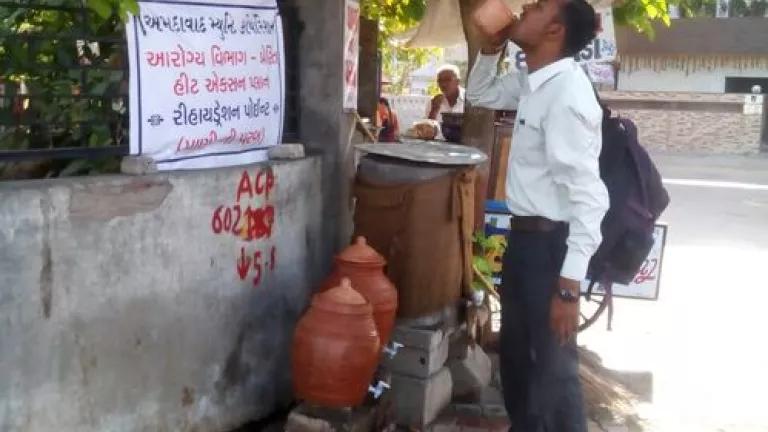
The tragic heat wave in India - with a current death toll over 1,800 - has raised a lot of attention to the dire threat of rising temperatures. The question many are asking is, what can local governments do to prepare for future heat waves and mitigate the terrible effects of heat on people?
Ahmedabad's Heat Action Plan was adopted three years ago, and offers a proven track record and model for other cities and states interested in adopting similar plans to protect their residents from heat waves.
One thing that is so attractive about the Ahmedabad's Heat Action Plan is that most of its effective strategies are very straight-forward to implement. There are many actions a city government can take immediately to save lives.
Dr. Tejas Shah - health officer at the Ahmedabad Municipal Corporation (AMC) and nodal (lead) officer of the Heat Action Plan (HAP) - provided the following summary of what the AMC and other stakeholders are doing right now in the city to warn and protect residents from the ongoing extreme heat.
- Posted large hoardings (billboards) & banners with heat preparedness messaging across the city, including in vulnerable slum areas and at all government hospitals & Urban Health Centers.
- Distributed more than 4 Lakh (400,000) handouts of heat preparedness messaging in repeated rounds among citizens, with a focus in slum and industrial areas, through link workers of each Urban Health Centers to sensitize citizens.
- Held meeting with all zones' Assistant Medical Officers and Junior Entomologists to discuss the HAP 2015, identifying drinking water sources and adding more throughout the city.
- Installed more than 1,100 drinking water stations around the city in collaboration with NGOs and social organizations together with the AMC.
- Conducted a survey of all construction sites (ward-wise) to see availability of drinking water and shelter for rest in afternoon for laborers working there. All construction sites will be given an order from the Estate Department to provide water and shelter to laborers.
- Keeping open all gardens in all zones as cooling spaces, including gardens that are generally closed over the noon hour.
- Have issued media advisory as in all leading newspapers, electronic and radio media to alert the public when there were temperatures forecast hot enough to quality as "orange days alerts" for upcoming next 3-4 days.
- Sending WhatsApp texts messages among all AMC department groups to sensitize citizens to avoid outdoors in afternoons until 4:30 pm during extreme heat days.
- Providing regular instructions to various departments like water department for no water supply cut and electricity department for no power cut during extreme heat days. Labor & Traffic police department received instructions to ensure safety of their workforce.
- Providing regular follow-up with all medical officers and government hospitals to take stock of their preparedness and management of heat-related cases.
- Keeping a close track on daily reports of heat-related illness & deaths from all government hospitals and on daily all-cause deaths as well to ensure there is no steep rise in death toll.
- Conducted sensitization & ToT (Training of Trainers) workshops with the help of IIPH-G & NRDC for various NGOs working for vulnerable communities.
- Schools have extended summer vacation so that students do not resume classes during the persisting heat wave and some schools are shifting to morning classes to avoid the hottest part of the day.
In addition to these critical actions happening now, there are many strategies that cities can adopt in the longer-term to increase resilience to the rising mercury. The Heat Action Plan offers ways to mitigate the health impacts of rising temperatures, including mapping high-risk heat areas, increasing access to drinking water stations & green spaces for shade, reducing urban heat island effects, ensuring new buildings are more heat-resilient, and developing transportation systems that help people avoid heat stress. All these actions and much more are necessary for cities and people in India and around the world already suffering from climate-fueled extreme heat.
###
Photo credit: City resident getting a drink at a water station in Ahmedabad, India, in May 2015. (c) Ahmedabad Municipal Corporation.
For background context, Ahmedabad is a city of 7 million people in the northwestern state of Gujarat, divided into zones and governed by the AMC. After a 2010 heat wave devastated the city, the AMC partnered with a coalition of local and international scientists and policy experts at the Indian Institute of Public Health, Gandhinagar, Public Health Foundation of India (PHFI), Natural Resources Defense Council, Icahn School of Medicine at Mount Sinai, and Rollins School of Public Health at Emory University to develop the Heat Action Plan. Georgia Institute of Technology's CFAN group provides a pioneering daily 7-day forecasts to the AMC to help them determine when to declare a heat alert. For more information about the creation of the Heat Action Plan, please see this prior blog.
More information about the Ahmedabad Heat Action Plan, including the Plan itself and supporting materials, is available here.
For additional recent blogs about this project protecting health against rising temperatures and heat waves in India:
- Blog on the Ahmedabad Heat Action Plan in the context of the current heat wave: http://switchboard.nrdc.org/blogs/ajaiswal/as_devastating_heat_wave_bears.html
- Blog on the transformation in the city's approach to heat emergencies after the Heat Action Plan was adopted as shown through local TV news: http://switchboard.nrdc.org/blogs/ajaiswal/ahmedabad_media_videos.html
- Medium article about how other cities can follow Ahmedabad's example: https://medium.com/natural-resources-defense-council/feeling-the-heat-91ad1c6a5cca
*UPDATED June 3, 2015 to reflect school closures due to long-lasting heat wave*
